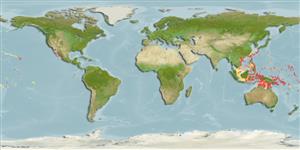>
Ovalentaria/misc (Various families in series Ovalentaria) >
Pseudochromidae (Dottybacks) > Pseudochrominae
Etymology: Pictichromis: Name from Latin pictus meaning painted or colored, and Greek Chromis, a genus of pomacentrid, used as the stem for other fish genera; alludes to the bright live colorations of the included species (Ref. 81967).
Environment: milieu / climate zone / depth range / distribution range
Ecología
marino asociado a arrecife; rango de profundidad 0 - 65 m (Ref. 9710), usually 0 - 15 m (Ref. 90102). Tropical; 30°N - 15°S
Western Pacific: Philippines to Samoa, north to Ryukyu Islands, south to Moluccas and Admiralty Islands.
Tamaño / Peso / Age
Maturity: Lm ? range ? - ? cm
Max length : 6.0 cm TL macho / no sexado; (Ref. 9710)
Espinas dorsales (total) : 3; Radios blandos dorsales (total) : 21 - 22; Espinas anales: 3; Radios blandos anales: 10 - 12. Easily identified by the bright purple color that looks bright blue in sunlit underwater conditions (Ref. 48635).
Hovers above coral or rubble and inhabits steep outer reef slopes and outer channel walls. Solitary or in small, loosely scattered groups at base of steep dropoffs (Ref 90102).
Life cycle and mating behavior
Maturities | Reproducción | Spawnings | Egg(s) | Fecundities | Larva
Myers, R.F., 1991. Micronesian reef fishes. Second Ed. Coral Graphics, Barrigada, Guam. 298 p. (Ref. 1602)
IUCN Red List Status (Ref. 130435)
Threat to humans
Harmless
Human uses
Pesquerías: comercial; Acuario: Comercial
Herramientas
Special reports
Download XML
Fuentes de Internet
Estimates based on models
Preferred temperature (Ref.
123201): 25.5 - 29.4, mean 28.7 °C (based on 1230 cells).
Phylogenetic diversity index (Ref.
82804): PD
50 = 0.5039 [Uniqueness, from 0.5 = low to 2.0 = high].
Bayesian length-weight: a=0.00490 (0.00187 - 0.01281), b=3.11 (2.88 - 3.34), in cm total length, based on LWR estimates for this (Sub)family-body shape (Ref.
93245).
Nivel trófico (Ref.
69278): 3.5 ±0.50 se; based on food items.
Fishing Vulnerability (Ref.
59153): Low vulnerability (10 of 100).
Nutrients (Ref.
124155): Calcium = 191 [95, 332] mg/100g; Iron = 0.942 [0.541, 1.634] mg/100g; Protein = 18.3 [17.1, 19.4] %; Omega3 = 0.123 [0.065, 0.231] g/100g; Selenium = 30.5 [12.8, 68.8] μg/100g; VitaminA = 145 [44, 456] μg/100g; Zinc = 2.29 [1.45, 3.34] mg/100g (wet weight);
